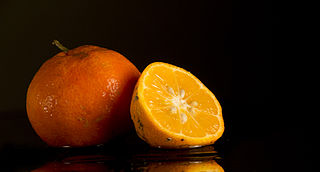
The mandarin orange, also known as mandarin or mandarine, is a small, rounded citrus tree fruit. Treated as a distinct species of orange, it is usually eaten plain or in fruit salads. Tangerines are a group of orange-colored citrus fruit consisting of hybrids of mandarin orange with some pomelo contribution.

The tangelo, Citrus × tangelo, is a citrus fruit hybrid of a Citrus reticulata variety, such as mandarin orange or tangerine, and a Citrus maxima variety, such as a pomelo or grapefruit. The name is a portmanteau of 'tangerine' and 'pomelo'.

The pomelo, from the family Rutaceae, is the largest citrus fruit, and the principal ancestor of the grapefruit. It is a natural, non-hybrid, citrus fruit, native to Southeast Asia. Similar in taste to a sweet grapefruit, the pomelo is commonly consumed and used for festive occasions throughout Southeast Asia and East Asia. As with the grapefruit, phytochemicals in the pomelo have the potential for drug interactions.

Citrus unshiu is a semi-seedless and easy-peeling citrus species, also known as the satsuma mandarin or Japanese mandarin. During the Edo period of Japan, kishu mikans were more popular because there was a popular superstition that eating Citrus unshiu without seeds made people prone to infertility. Citrus unshiu became popular in Japan after modernization started in the Meiji period. It was introduced to the West from the Satsuma region of Japan in 1878.

Sudachi is a small, round, green citrus fruit of Japanese origin that is a specialty of Tokushima Prefecture in Japan. It is a sour citrus, not eaten as fruit, but used as food flavoring in place of lemon or lime. Genetic analysis shows it to be the product of a cross between a yuzu and another citrus akin to the koji and tachibana orange.

Citrus depressa (Citrus × depressa, formerly C. pectinifera, Okinawan: シークヮーサー/シークァーサー, romanized: shiikwaasa, Japanese: ヒラミレモン, romanized: hirami remon or シークワーサー, shiikuwāsā, in English sometimes called shiikuwasha, shequasar, Taiwan tangerine, Okinawa lime, flat lemon, hirami lemon, or thin-skinned flat lemon, is a small citrus fruit often harvested and used when green, rich in flavonoids and native to East Asia.

The tangor is a citrus fruit hybrid of the mandarin orange and the sweet orange. The name "tangor" is a formation from the "tang" of tangerine and the "or" of "orange." Also called the temple orange, its thick rind is easy to peel and its bright orange pulp is sour-sweet and full-flavoured.

The iyokan, also known as anadomikan (穴門みかん) and Gokaku no Iyokan, is a Japanese citrus fruit, similar in appearance to a mandarin orange, with Dancy as the pollen parent and Kaikokan as the seed parent. It is the second most widely produced citrus fruit in Japan after the satsuma mandarin. Ehime Prefecture accounted for 90% of Iyokan production in 2021.

The mandarinquat, also misleadingly called orangequat, is any cross between a mandarin and a kumquat. Mandarinquats are members of the citrofortunella group.

Rangpur, Citrus × limonia or Citrus reticulata × medica, sometimes called the rangpur lime, mandarin lime or lemandarin, is a hybrid between the mandarin orange and the citron. It is a citrus fruit with a very acidic taste and an orange peel and flesh.

Sweet lemon and sweet lime refer to groups of citrus hybrids that contain low acid pulp and juice. They are hybrids often similar to non-sweet lemons or limes, but with less citron parentage. Sweet limes and lemons are not sharply separated:
The sweet lime, Citrus limettioides Tan., is often confused with the sweet lemon, C. limetta Tan., which, in certain areas, is referred to as "sweet lime". In some of the literature, it is impossible to tell which fruit is under discussion.

The Kojiki and Nihon Shoki, compiled in the 700s, were the first books in Japan to describe citrus fruits. The Nihon Shoki states that a man named Tajimamori brought back citrus fruits from the Tokoyo no kuni on the orders of Emperor Suinin, which is thought to refer to the tachibana orange that grows wild in Japan. The Man'yōshū, a collection of poems from the same period, contains many poems about tachibana orange, and because of its strong acidity at the time, it was dried and used for medicinal and ornamental purposes rather than for food. The Kokin Wakashū, compiled in the 900s, mentions that tachibana orange was burned and used as incense to give a nice fragrance to kimonos. In Japan, tachibana orange is a symbol of eternity and is the motif for the Order of Culture.

Reikou is a cultivar of tangor. It is a citrus hybrid of a hybrid of Kiyomi and Encore and Murcott tangor.

Jabara is a hybrid species of plant and fruit that is among the Japanese citrus.

Hassaku, Citrus × hassaku, is a Japanese citrus hybrid between pomelo and mandarin, with pomelo-like characteristics. The original plant was discovered near the Jyoudo temple in Inno-shima, Hiroshima prefecture, Japan.
Procimequat is a triploid citrus hybrid or transgeneric hybrid, x Fortunella hindsii, in which the limequat that itself is a cross between lime and a round kumquat, was backcrossed with the primitive Hong Kong kumquat.

The Murcott is a tangor, or mandarin–sweet orange hybrid.
Neurogenesis is the process by which nervous system cells, the neurons, are produced by neural stem cells (NSCs). This occurs in all species of animals except the porifera (sponges) and placozoans. Types of NSCs include neuroepithelial cells (NECs), radial glial cells (RGCs), basal progenitors (BPs), intermediate neuronal precursors (INPs), subventricular zone astrocytes, and subgranular zone radial astrocytes, among others.

Koji orange, also called smooth-fruited orange in English, bingyul in Korean, 光橘, 柑 子, and 日本土柑 in Chinese, and コウジ (kōji) in Japanese, is a Citrus species native to Japan. The specific epithet (leiocarpa) comes from Greek leios and karpon. It is a taxonomical synonym of Citrus aurantium.

Haruka is a Citrus cultivar grown in Japan and the Korean Peninsula.




















